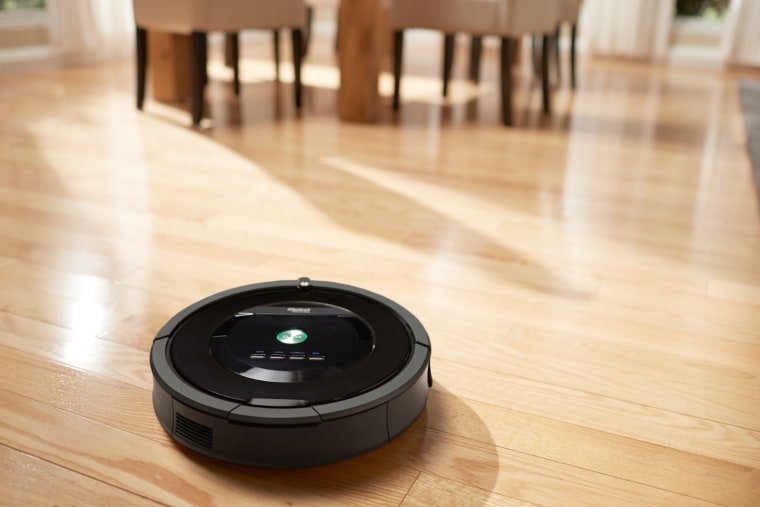It may not have the personality of Rosie, the housekeeper robot from "The Jetsons," but at least Roomba, iRobot's persistent, intelligent hockey puck-shaped cleaner robot, can find its own way around the house.
The 880, introduced Tuesday, is the newest member of the Roomba family, iRobot's line of robotic autonomous vacuum cleaners that have become wildly popular with house cats as well as humans, who've bought millions of units since the bots first went on sale in 2002.
With revamped innards, the 880 sucks 50 percent more dirt than its predecessors, iRobot claims. The 880 sells for $699.99 — about $50 more than top-of-the-range upright model from Dyson but about three times as much as the best Hoover, both of which you still need to push around the house.
The 880's new stuff is on the underbelly of the bot; flip it over and you’ll see. The bristles that rim the rectangular jaws of earlier models are swapped out for two ridged, rotating cylinders that are specially designed to chew through that common enemy of upright and robotic vacuum cleaners: hair.
"They will break apart the hair and suck it right into the system," Max Makeev, product manager at iRobot, told me. It doesn’t matter if it’s long, windy strands of human hair or shorter, lighter pet fluff, or if said hair is on tiling, hardwood, area rugs, linoleum or carpeting, he said.
"Think about it, the brush has been around for 100 years, we’ve just disrupted that technology," Makeev said before a test unit sucked up a rash of M&Ms scattered on the carpeting at a suite at the Westin New York, 36 floors above Grand Central Station. "No matter how much suction those uprights have, they’re not pulling the hair off the brushes." That’s the human’s job.
In my small apartment, the new bot had no trouble getting on and off area rugs and did a nice job of cleaning up a room — even the corners — that hadn’t seen a broom in days. The extractors were hair-free when it found its way back to the docking station, except for one stray strand. Unfortunately, on the bot's belly, there remains one three-pronged rotating brush, which feeds debris into the main suction vent. And that had gathered a giant hairball, which I then had to pick off with my fingers.
Aside from (almost) saving you the trouble of pulling apart giant hairballs clogging the bristles of your vacuum cleaner or broom, the extractors are built to swallow solids better, too. They are flexible and bend apart to eat larger clutter like Cheerios or Goldfish or glass shards. The design focuses the suction in the small gap between the rotating rods, forcing the air through them, when previously the air would diffuse through a forest of bristles.
The ridged rollers work "like a squeegee and a comb at the same time," according to Makeev. "[The Roomba] is able to harvest debris that’s loosely sitting on carpets or hardwood floors or reach deep and comb up debris and fine dust."
The guts of the bot have gotten a do-over as well, as part of iRobot’s new "AeroForce Technology" redesign. A longer-lasting battery is stored in the belly, as is a more powerful, smaller vacuum. This made room for a larger collecting bin that stores 60 percent more dirt than earlier models, meaning it doesn't have to be cleared out by hand as often.
In appearance, the 880 does resemble its older cousins, though the glossy black and slate gray paneling and a green-glowing "On" button in the middle with a brushed-steel finish give it a bit more sophisticated appearance. The new model is built to clean four 10-foot-by-10-foot rooms per battery charge before it self-docks.
Of course, the big thing that stays the same is its appeal to house pets. "I think cats are going to enjoy riding this robot," Makeev said, laughing. "It’s one of the smoothest rides out there."
Nidhi Subbaraman writes about technology and science. You can follow her on Facebook, Twitter and Google+.
